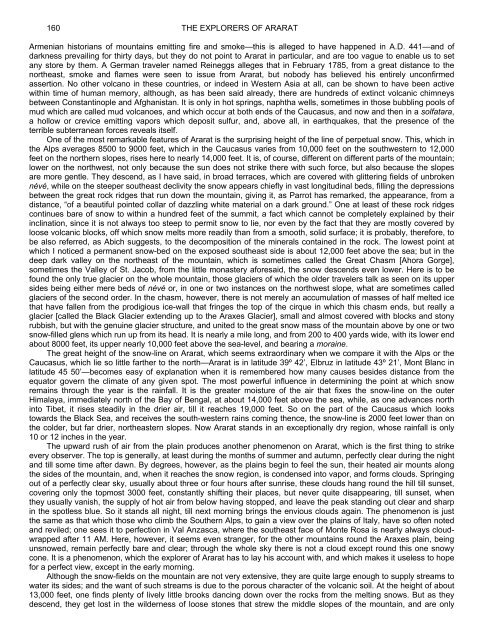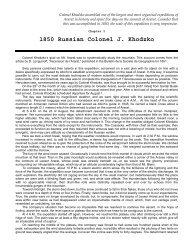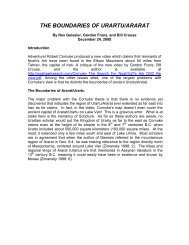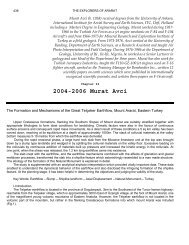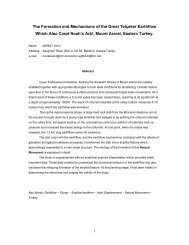1876 British Viscount & Ambassador James Bryce - Noah's Ark Search
1876 British Viscount & Ambassador James Bryce - Noah's Ark Search
1876 British Viscount & Ambassador James Bryce - Noah's Ark Search
You also want an ePaper? Increase the reach of your titles
YUMPU automatically turns print PDFs into web optimized ePapers that Google loves.
160 THE EXPLORERS OF ARARAT<br />
Armenian historians of mountains emitting fire and smoke—this is alleged to have happened in A.D. 441—and of<br />
darkness prevailing for thirty days, but they do not point to Ararat in particular, and are too vague to enable us to set<br />
any store by them. A German traveler named Reineggs alleges that in February 1785, from a great distance to the<br />
northeast, smoke and flames were seen to issue from Ararat, but nobody has believed his entirely unconfirmed<br />
assertion. No other volcano in these countries, or indeed in Western Asia at all, can be shown to have been active<br />
within time of human memory, although, as has been said already, there are hundreds of extinct volcanic chimneys<br />
between Constantinople and Afghanistan. It is only in hot springs, naphtha wells, sometimes in those bubbling pools of<br />
mud which are called mud volcanoes, and which occur at both ends of the Caucasus, and now and then in a solfatara,<br />
a hollow or crevice emitting vapors which deposit sulfur, and, above all, in earthquakes, that the presence of the<br />
terrible subterranean forces reveals itself.<br />
One of the most remarkable features of Ararat is the surprising height of the line of perpetual snow. This, which in<br />
the Alps averages 8500 to 9000 feet, which in the Caucasus varies from 10,000 feet on the southwestern to 12,000<br />
feet on the northern slopes, rises here to nearly 14,000 feet. It is, of course, different on different parts of the mountain;<br />
lower on the northwest, not only because the sun does not strike there with such force, but also because the slopes<br />
are more gentle. They descend, as I have said, in broad terraces, which are covered with glittering fields of unbroken<br />
névé, while on the steeper southeast declivity the snow appears chiefly in vast longitudinal beds, filling the depressions<br />
between the great rock ridges that run down the mountain, giving it, as Parrot has remarked, the appearance, from a<br />
distance, “of a beautiful pointed collar of dazzling white material on a dark ground.” One at least of these rock ridges<br />
continues bare of snow to within a hundred feet of the summit, a fact which cannot be completely explained by their<br />
inclination, since it is not always too steep to permit snow to lie, nor even by the fact that they are mostly covered by<br />
loose volcanic blocks, off which snow melts more readily than from a smooth, solid surface; it is probably, therefore, to<br />
be also referred, as Abich suggests, to the decomposition of the minerals contained in the rock. The lowest point at<br />
which I noticed a permanent snow-bed on the exposed southeast side is about 12,000 feet above the sea; but in the<br />
deep dark valley on the northeast of the mountain, which is sometimes called the Great Chasm [Ahora Gorge],<br />
sometimes the Valley of St. Jacob, from the little monastery aforesaid, the snow descends even lower. Here is to be<br />
found the only true glacier on the whole mountain, those glaciers of which the older travelers talk as seen on its upper<br />
sides being either mere beds of névé or, in one or two instances on the northwest slope, what are sometimes called<br />
glaciers of the second order. In the chasm, however, there is not merely an accumulation of masses of half melted ice<br />
that have fallen from the prodigious ice-wall that fringes the top of the cirque in which this chasm ends, but really a<br />
glacier [called the Black Glacier extending up to the Araxes Glacier], small and almost covered with blocks and stony<br />
rubbish, but with the genuine glacier structure, and united to the great snow mass of the mountain above by one or two<br />
snow-filled glens which run up from its head. It is nearly a mile long, and from 200 to 400 yards wide, with its lower end<br />
about 8000 feet, its upper nearly 10,000 feet above the sea-level, and bearing a moraine.<br />
The great height of the snow-line on Ararat, which seems extraordinary when we compare it with the Alps or the<br />
Caucasus, which lie so little farther to the north—Ararat is in latitude 39º 42’, Elbruz in latitude 43º 21’, Mont Blanc in<br />
latitude 45 50’—becomes easy of explanation when it is remembered how many causes besides distance from the<br />
equator govern the climate of any given spot. The most powerful influence in determining the point at which snow<br />
remains through the year is the rainfall. It is the greater moisture of the air that fixes the snow-line on the outer<br />
Himalaya, immediately north of the Bay of Bengal, at about 14,000 feet above the sea, while, as one advances north<br />
into Tibet, it rises steadily in the drier air, till it reaches 19,000 feet. So on the part of the Caucasus which looks<br />
towards the Black Sea, and receives the south-western rains coming thence, the snow-line is 2000 feet lower than on<br />
the colder, but far drier, northeastern slopes. Now Ararat stands in an exceptionally dry region, whose rainfall is only<br />
10 or 12 inches in the year.<br />
The upward rush of air from the plain produces another phenomenon on Ararat, which is the first thing to strike<br />
every observer. The top is generally, at least during the months of summer and autumn, perfectly clear during the night<br />
and till some time after dawn. By degrees, however, as the plains begin to feel the sun, their heated air mounts along<br />
the sides of the mountain, and, when it reaches the snow region, is condensed into vapor, and forms clouds. Springing<br />
out of a perfectly clear sky, usually about three or four hours after sunrise, these clouds hang round the hill till sunset,<br />
covering only the topmost 3000 feet, constantly shifting their places, but never quite disappearing, till sunset, when<br />
they usually vanish, the supply of hot air from below having stopped, and leave the peak standing out clear and sharp<br />
in the spotless blue. So it stands all night, till next morning brings the envious clouds again. The phenomenon is just<br />
the same as that which those who climb the Southern Alps, to gain a view over the plains of Italy, have so often noted<br />
and reviled; one sees it to perfection in Val Anzasca, where the southeast face of Monte Rosa is nearly always cloudwrapped<br />
after 11 AM. Here, however, it seems even stranger, for the other mountains round the Araxes plain, being<br />
unsnowed, remain perfectly bare and clear; through the whole sky there is not a cloud except round this one snowy<br />
cone. It is a phenomenon, which the explorer of Ararat has to lay his account with, and which makes it useless to hope<br />
for a perfect view, except in the early morning.<br />
Although the snow-fields on the mountain are not very extensive, they are quite large enough to supply streams to<br />
water its sides; and the want of such streams is due to the porous character of the volcanic soil. At the height of about<br />
13,000 feet, one finds plenty of lively little brooks dancing down over the rocks from the melting snows. But as they<br />
descend, they get lost in the wilderness of loose stones that strew the middle slopes of the mountain, and are only


